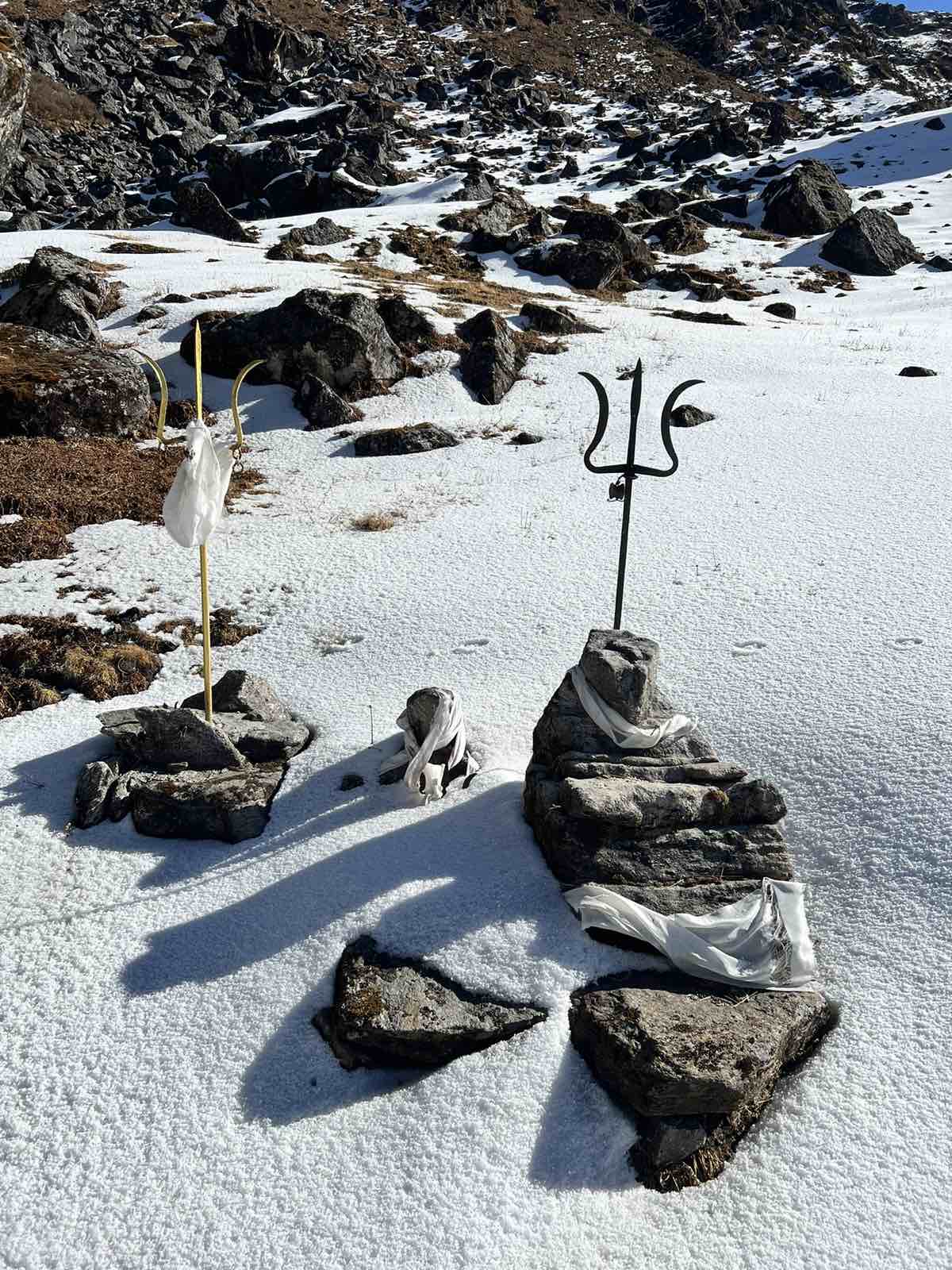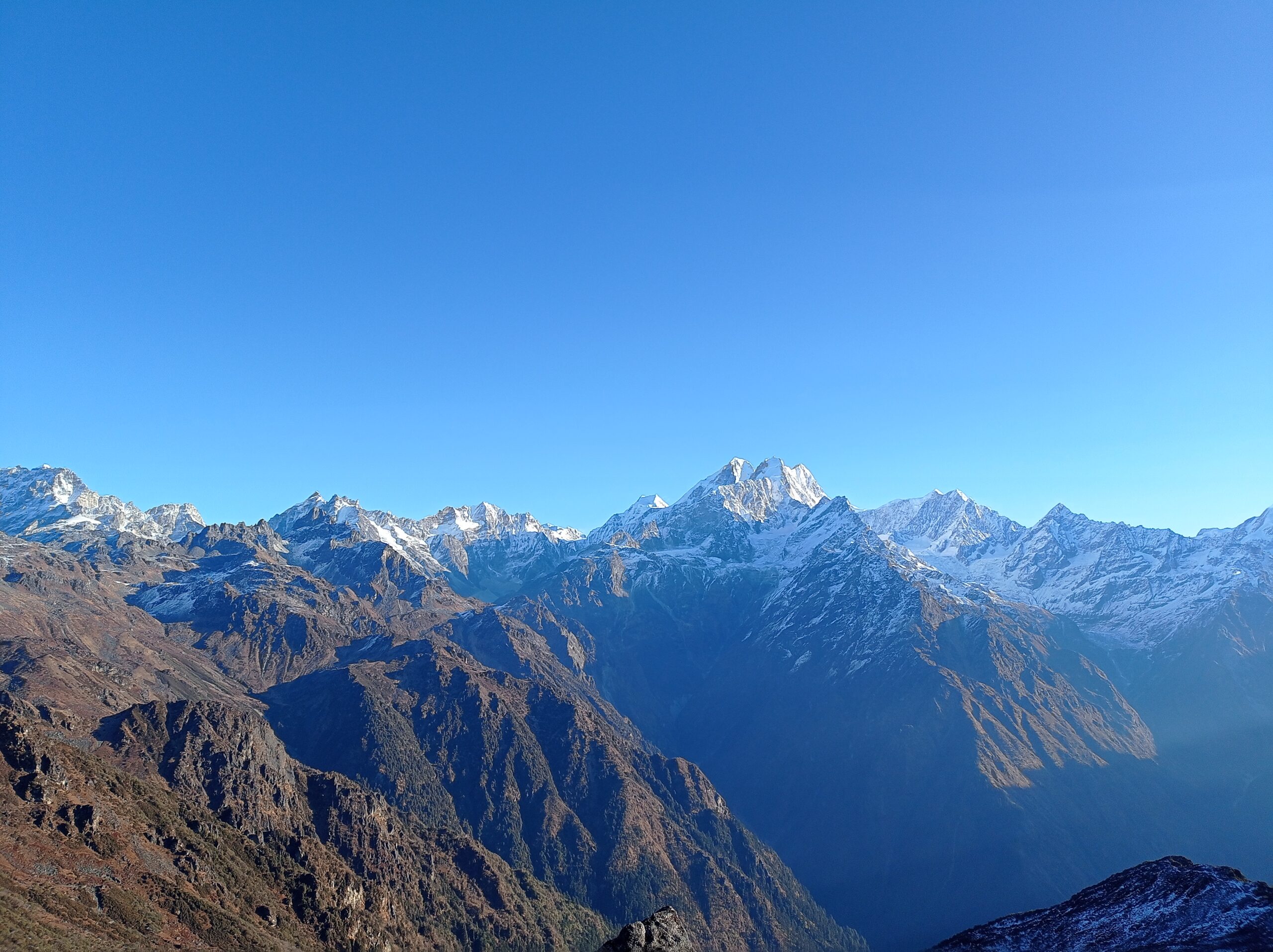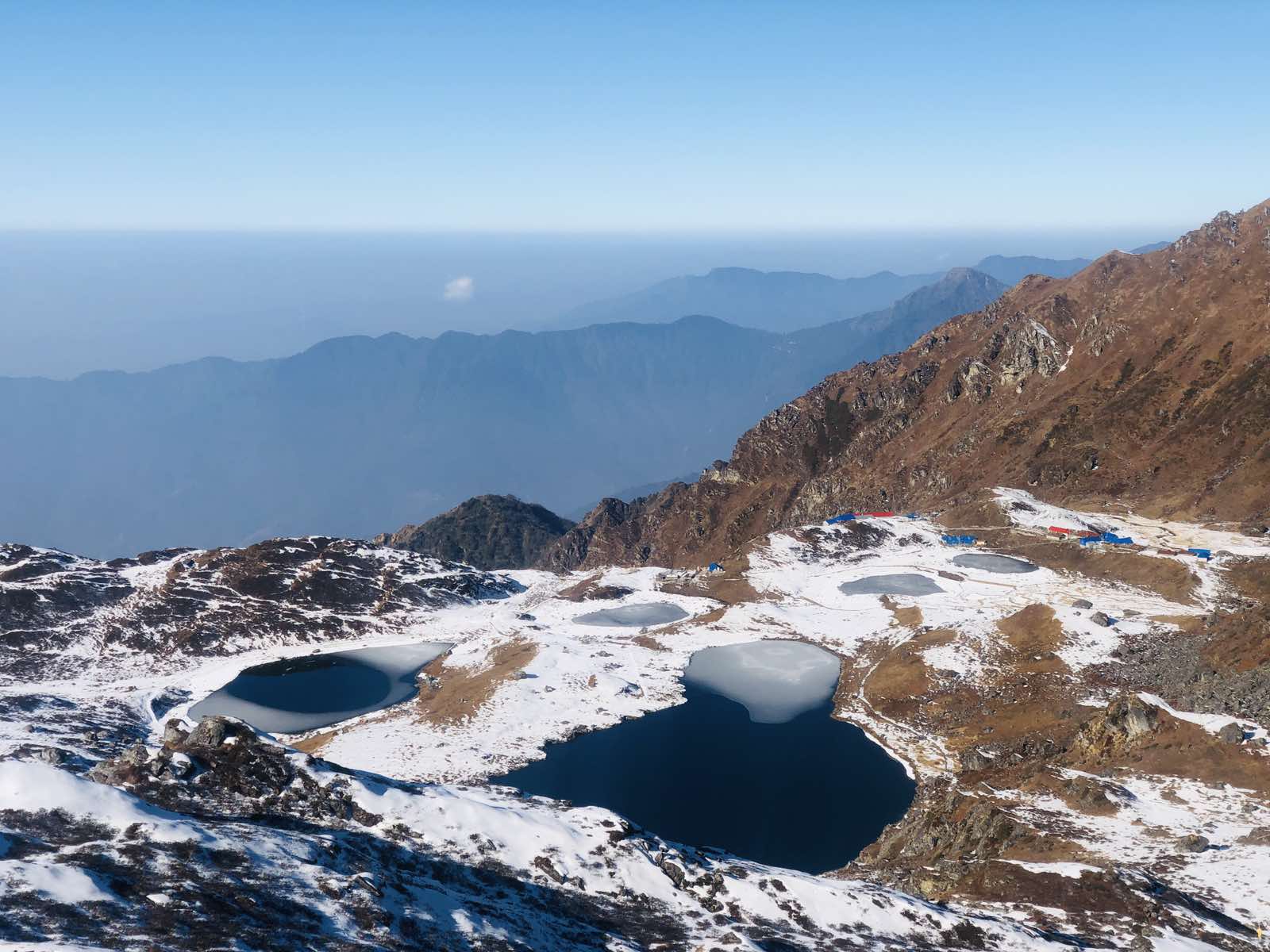Panch Pokhari comprises a collection of five sacred Hindu lakes situated in the Sindhupalchowk District of Nepal. It ranks as the ninth-highest-altitude wetland globally. This site attracts numerous Hindu and Buddhist pilgrims, serving as a significant destination for spiritual journeys. Panch Pokhari remains relatively untouched, representing a pristine and well-conserved aspect of nature. Its breathtaking landscapes and remarkable vistas are truly captivating. The stunning mountain views, along with the unspoiled natural environment and diverse wetland ecosystems, render this location a must-visit in the remote mountainous regions of Nepal.
Panch Pokhari is a prominent feature within Langtang National Park, which spans the Nuwakot, Rasuwa, and Sindhupalchowk districts in the central Himalayas. In 2011, the Postal Series Department of the Nepalese government issued a stamp that showcased this remarkable site. The lakes are located at an altitude of approximately 4,100 meters above sea level and are recognized as a significant pilgrimage destination for Hindus in Nepal.
The trekking route to Panch Pokhari lies to the north of the Kathmandu Valley, within the Jugal Himal range, which includes peaks such as Dorje Lakpa, Madiya, and Phurbi Chhyachu. This trek offers visitors the opportunity to immerse themselves in the rich cultural heritage of the Tamang and Sherpa communities. For those seeking a trek that combines spirituality, tranquility, and natural beauty, this camping trek is an ideal choice.
In the fast-paced environment of urban life, many individuals yearn for a remarkable retreat into nature. Panch Pokhari stands out as one of the most stunning locations in the world. The breathtaking views of the settlements and the lake system in Sindhupalchowk are among the most enchanting aspects to discover.
Where is Panch Pokhari?

Panch Pokhari is a newly established trekking destination in Nepal, situated at an elevation of 4,100 meters to the northeast of Kathmandu, at the foothills of the Jugal Himal. This location holds significant cultural, religious, and ecological value. Each year in August, it hosts the Janai Purnima festival, during which individuals from the Brahmin community gather to perform the ritual of changing their sacred thread, known as Janai.
The five ponds, collectively referred to as Panch Pokhari, are considered sacred. Nestled at the base of the Jugal Himal, this area boasts a diverse ecology of considerable importance. The trekking route traverses through Sherpa and Tamang villages, offering a rich cultural experience of Nepal.
Activities in Panch Pokhari
Panch Pokhari is a realm of adventure and intrigue, characterized by its varied geographical landscapes, rich flora and fauna, and breathtaking mountain views. Visitors can engage in numerous activities, from immersing themselves in nature to venerating the lakes and enjoying the serene spiritual ambiance.
Trekking
The Panch Pokhari trek is a less commercialized trail in Nepal, providing stunning views of the Himalayas, including Gauri Shanker, Dorje Lakpa, the Langtang range, the Jugal range, the Rolwaling range, and the Tibetan range, alongside the opportunity to experience the local culture and pristine nature. The name Panch Pokhari signifies the five sacred ponds, which are held in high regard by Hindus.
Yoga and Meditation
Yoga is a holistic practice that harmonizes the mind and body, with roots in the Himalayan regions dating back thousands of years. The contemporary practice of yoga has been shaped by figures such as Lord Shiva, Lord Buddha, the esteemed sage Patanjali, and various yogis. Meditation is an essential practice for daily life, fostering tranquility, mental clarity, and overall well-being. It contributes to improved relationships, enhanced health, and a more fulfilling life.1. Nepal is renowned as one of the premier destinations globally for the practice of Yoga and Meditation. The country boasts numerous picturesque locations where visitors can engage in these practices. In recent times, a variety of institutes have emerged, providing yoga and meditation classes in serene, clean, and breathtaking environments.
Camping is an outdoor pursuit that entails spending nights away from home in a temporary shelter, such as a tent. Participants typically venture away from developed areas to immerse themselves in more natural settings, engaging in activities that bring them joy. To qualify as ‘camping,’ one must spend at least one night outdoors, distinguishing it from day trips and other brief excursions. This activity can be enjoyed in all four seasons.
The Panch Pokhari camping trek takes adventurers through pristine traditional villages set against the stunning backdrop of the Himalayas. It offers an unparalleled trekking experience along a less-traveled path, leading through untouched wilderness and unspoiled communities in the mountains of Nepal.
This journey to Panch Pokhari, located at the base of Jugal Himal, presents breathtaking mountain vistas, a rich cultural tapestry, and authentic adventure. This remarkable region combines a deep cultural heritage with extraordinary natural beauty and biodiversity as trekkers make their way to a series of high-altitude sacred lakes revered by both Buddhist and Hindu communities.
Sightseeing in Nepal is a highly sought-after experience. Renowned for its rich history, captivating art, and unique architectural styles, Nepal stands out as one of the premier destinations for sightseeing. The attractions at Panch Pokhari are truly mesmerizing and never fail to impress visitors. Additionally, the stunning vistas of Dorje Lakpa, Phurbu Chhyachu, Madiya, Jugal Himal, Rolwaling, and the Langtang range are prominently visible from this location.
Religious Merits

Each year, during the festival of Janai Purnima, which typically occurs in August, numerous pilgrims from across the nation flock to the sacred ponds. This festival marks the occasion when Brahmin individuals in Nepal renew their Janai, a sacred thread worn around the body. Pilgrims travel to Panch Pokhari to bathe in the ponds and perform the ritual of changing their Janai. Nestled in the shadow of the Jugal Himal, the ecological diversity of the area further enhances its appeal for camping, thereby supporting the principles of green tourism.
Religious Significance of Panch Pokhari
Panch Pokhari is a remarkable site featuring five exquisite lakes, which are believed to be the source of the Indravati River. The significance of Panch Pokhari is documented in the Panch Pokhari Mahatmyam, Skanda Purana, and Himwat Khand, which highlight the importance of Bhairav Kunda, Saraswati Kunda, Surya Kunda, and Nag Kunda as pilgrimage sites comparable to Tirthraj Prayag and Badganga Kurukshetra.
According to five Tibetan scriptures, the Hyolmo region of Helambu, where the Gupta Mantra tantra Nidhi is thought to be concealed, is regarded as a sacred place of meditation and the source of Tantra mantra Siddhi. It is believed that revered figures such as Param Guru Rinpoche (Padmasambhava), Mahayogi Milarepa, Ama Yangri, and Ananta Autari Lama Guru have meditated in this pristine area.
Numerous domestic tourists and visitors set out on their journey to the five ponds, which host a grand fair in celebration of Ekadashi and Janai Purnima.
The lake’s shimmering sapphire hue, along with the vibrant mountains and expansive sky, creates an extraordinary atmosphere at this location. A breathtaking sight is the array of clouds enveloping the stunning snow-capped peaks surrounding the five crystal-clear lakes, making this destination in Nepal truly remarkable.
The beauty of this place inspires visions of Vibhuti Jugal, the sovereign of white snow; Lakpa Dorje, the guardian of the five ponds; and Simi Sidang, the deity of Hyolmo from Helambu, gazing upon the ponds. At an elevation of 4,200 meters above sea level, anyone who beholds this natural wonder would be inclined to regard it as a veritable paradise on earth.
According to local legend, the Panchpokhari region is revered as the dwelling of Lord Shiva and Parvati, with the five ponds symbolizing their daughters. The ponds are named Jethi, Mahili, Sahili, Kaili, and Kanchi Pokhari, respectively, from right to left. This remarkable natural formation is unique to Nepal, and the harmonious blend of its spiritual and natural significance renders it an ideal site for exploration.
Panch Pokhari Weather
During the autumn months (September to November) and spring (March to May), visitors can enjoy unobstructed views of the surrounding mountain range, complemented by a clear blue sky adorned with beautifully scattered white clouds. The monsoon season (June to September) brings rainfall, which can complicate access to the area. Winter (December to February) presents harsher conditions, characterized by heavy snowfall.
Accessing Panch Pokhari can be accomplished through two distinct trekking routes. The first route commences from Sano Okhareni, passing through Chautara, while the second begins at Bhotang, proceeding via Melamchi. Among these, the Bhotang route is regarded as the most straightforward and favored option for trekking to Panch Pokhari.
The journey initiates from Bhotang, which can be reached by a drive from Kathmandu. Along the way, travelers can enjoy remarkable settlements of various cultural groups, stunning natural landscapes, and an array of flora and fauna. The trek from Bhotang leads to Deurali and subsequently to Nasempati, where picturesque valleys, meandering rivers, and streams serve as key attractions. As you advance towards Laure Bhanjyang, the sight of terraced farmlands and diverse vegetation becomes prominent. Laure Bhanjyang also serves as the final resting point before arriving at Panch Pokhari.
Upon reaching Panch Pokhari, visitors can immerse themselves in the breathtaking beauty of the wetland. Following this exploration, the return journey to Tangu and the trek back to Bhotang will commence. From Bhotang, travelers can secure transportation back to Kathmandu via Melamchi.
Panch Pokhari Short Trek
The Panch Pokhari trek offers an opportunity to discover the enchanting countryside within the mountain wetlands of Nepal. The trek is characterized by its stunning scenery, cultural villages, flowing rivers, valleys, and a serene atmosphere, all of which are significant draws for trekkers. Additionally, participants can appreciate the expansive mountain panorama and a rich variety of flora and fauna.
This trekking region is marked by its diversity, allowing adventurers to experience the beauty of mountains, wetlands, and remote settlements, as well as the cultural habitats of the area. The Panch Pokhari trek seamlessly combines a multitude of experiences, creating a unique and memorable journey.
The Panch Pokhari trek is classified as a trek of moderate difficulty, situated in the Langtang Helambu region, which remains relatively unexplored and less frequented by tourists. This makes a visit to the area particularly rewarding in terms of the unique experiences it offers. The region is largely uninhabited, presenting challenges regarding accommodation options. While a few teahouses can be found in the lower elevations, trekkers may need to rely on camping at higher altitudes. One of the most captivating aspects of this trek is the opportunity to immerse oneself in the remote and rural ambiance amidst the stunning landscapes of Nepal.
This trekking route ascends to elevations exceeding 4,000 meters, which increases the risk of altitude sickness. Proper medication and precautionary measures are essential to reduce the likelihood of severe Acute Mountain Sickness. Consequently, it is crucial to familiarize oneself with the symptoms and management of altitude sickness prior to embarking on this trek.
The winter and summer months are not advisable for trekking in this region. The monsoon and summer seasons pose geographical hazards, as the mountain terrain becomes susceptible to avalanches and landslides. Therefore, these periods should be avoided. Additionally, trekkers may encounter leeches and earthworms along the trails, which can be unpleasant. The unpredictable weather conditions during summer further render the mountainous areas less favorable for trekking.
While winter offers a wonderful opportunity to explore new destinations, the heavy snowfall and frigid temperatures at higher elevations, coupled with overcast skies, create unfavorable conditions. There is also a risk of losing the trekking path due to the gloomy and snowy atmosphere, which can be quite challenging. Thus, trekking during the monsoon and winter seasons is best avoided.
The optimal times to visit Panch Pokhari are during the spring and autumn seasons. Autumn spans September, October, and November, while spring includes March, April, and May. These seasons are favored for trekking due to the moderate sunshine and minimal precipitation, making them ideal for completing the trek.

